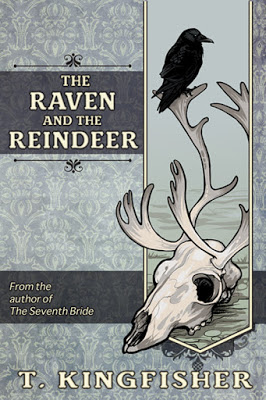Welcome to another session of Turning Pages!
Synopsis: This book was my Valentine’s gift to myself.
Once upon a time in Hans Christian Andersonland, an evil troll creates a mirror which reflects things as they are not. Facing beauty, it regardless shows ugliness. On a lark, taking the mirror up to heaven to make fools of the angels (!) the mirror somehow falls to the earth and breaks. Mirror shards get into people’s hearts, and freezes their affections. Then they can no longer see beauty, good, or happiness in anything. One summer a boy becomes cold and mean and horrible to his dearest friend, and only finds beauty in the perfection of snowflakes. Instead of backhanding him as he so richly deserves, she rightly fears that he has got a mirror-shard in his heart and, pitying him, determines that she should somehow do something to help him.
As winter draws on, the boy meets a woman in a fur coat in the market, and she takes him away, finding him cold enough for her wintry tastes. His friend, desperately loyal, goes after him into the deep North of winter, because she is wise and good and true. She is delayed and diverted by the whipping winds of Winter, but has help from the people of the North, including a robber girl, a great black crow, and a reindeer. The girl saves her friend from the Queen of the Snow with prayers and miracles, and a little help from her friends, and all’s well that ends well; it’s summertime again. The End.
Anderson wrote “The Snow Queen” in 1844, and this somewhat convoluted and bizarre original story has spawned myriad rewrites and imitators from CS Lewis’ White Witch in The Chronicles of Narnia to the more recent “Frozen” and “The Huntsman” films. I kinda hate the mythos; winter can be trying enough without imagining it being the fault of an evil troll or an woman of great beauty who heartlessly freezes humans, but having someone to actively hate also sometimes helps.
 Observations: T. Kingfisher’s version of this story is wonderful, for myriad reasons. Gerda is clearly good and honest and true, but she’s also kind of ridiculous, as she is filled with determination and nothing more. The narrative lets you know up front that sometimes that’s the worst thing a girl can be, because life takes advantage of people who believe that determination is all that they need, and not, like, actual skill or preparation or OTHER PEOPLE’S HELP – life will eat you in one gulp, if you’re that silly. And, Gerda gets eaten for awhile, and it’s not all terrible or evil, what happens, — it’s worse, it’s well-meaning which is very bad indeed. Which just goes to show you: sometimes the very worst thing is not at all what you feared.
Observations: T. Kingfisher’s version of this story is wonderful, for myriad reasons. Gerda is clearly good and honest and true, but she’s also kind of ridiculous, as she is filled with determination and nothing more. The narrative lets you know up front that sometimes that’s the worst thing a girl can be, because life takes advantage of people who believe that determination is all that they need, and not, like, actual skill or preparation or OTHER PEOPLE’S HELP – life will eat you in one gulp, if you’re that silly. And, Gerda gets eaten for awhile, and it’s not all terrible or evil, what happens, — it’s worse, it’s well-meaning which is very bad indeed. Which just goes to show you: sometimes the very worst thing is not at all what you feared.
Kai, the Kidnapped, meanwhile… well, Kai is… you just want to slap his little perfect blonde head ’til he rolls down a hill. He’s sappy and dreadful. Hans Christian Anderson made him out to be eminently desirable and save-able, the scope and reason for Gerda even being in the story is to Save Kai. He is not, however, very worth saving; he is a mean little ice-eyed weasel, with apologies to weasels. Gerta loves him, so you make allowances… however, the droll narrative voice gives the reader the information that Mr. Anderson didn’t bother with — that sometimes loving someone not worth your effort is a joyless drudge, and very, very hard. This takes the story from the realm of fable or fairytale, right out into the real.
In another realistic twist, Gerda and Kai don’t suit. At all. I mean, that’s obvious to you and me right out the gate, but Mr. Anderson would have twisted the story around so somehow self-sacrificing Gerda would somehow deserve Kai, for all her sins. Kingfisher obviously thinks she’s suffered enough. Gerda is meant for someone else entirely, and it’s a bit of a surprise at first – for her too – but then it seems to make sense. The reindeer is selfless — but selflessness usually means sacrifice, and most times, sacrifice is not pretty. The crow is… well, a crow. It wants eyeballs, really. And to give out sassy backtalk and bad advice. And, it’s responsible for Gerda getting in more trouble – and getting more help – than she expects, and it’s a much more fun character here than in the original.
Conclusion:T. Kingfisher, in the person of Ursula Vernon writing for adults, has so far only published her fairytales as ebooks, but at least one has been picked up by publishers to appear in print, so if you’re a paper-book person, don’t lose hope – this one will likely also make the cut because it’s original and funny. Meanwhile, this is another winner of a story, has positive LGBTQ content, realistic information about the indigenous peoples of Scandinavia, and reprises the valuable – and not-often-expressed theme that some boys are not worth spending one’s time and life running after. I really like how many Kingfisher fairytales underscore this truth in droll and amusing ways. The author continues to depict the world as it is, rather than as some lovely and well-meaning but otherwise completely bizarre Swedish story states that it should be.
I purchased my copy of this book because Kingfisher Fairytales are for me an auto-buy. You can find THE RAVEN AND THE REINDEER by T.Kingfisher at an online e-tailer near you!

Oh, this sounds good. I have to start reading these… Ursula Vernon is a superhero.